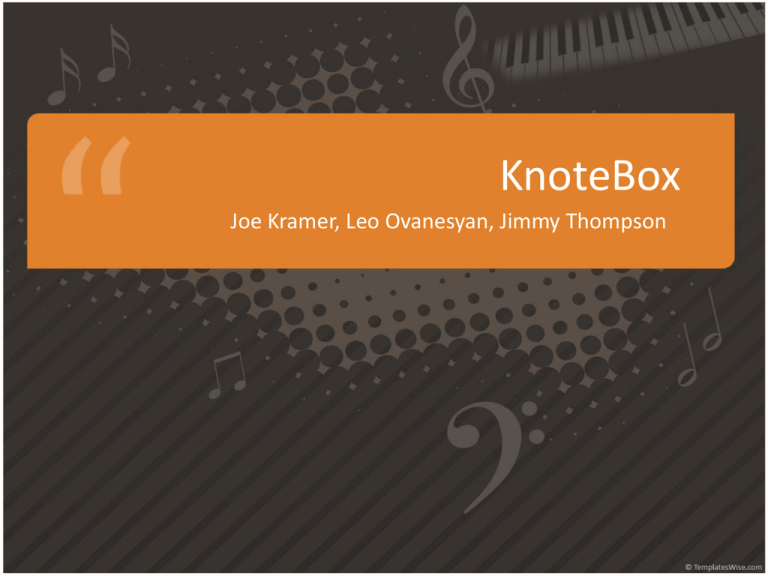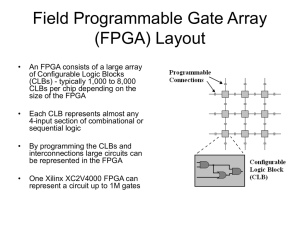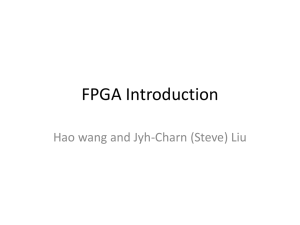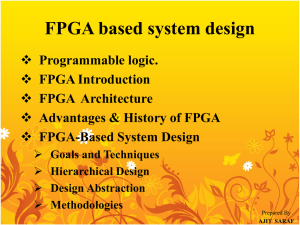KnoteBox
advertisement

KnoteBox Joe Kramer, Leo Ovanesyan, Jimmy Thompson Project Objectives • Recognize musical notes from an analog sound input in real-time and output MIDI data to a computer MIDI KnoteBox System Overview Power ctrl Audio in ADC/ filters FPGA MCU External Power USB ctrl USB out Algorithm Overview Analog waveform Time frequency data FPGA Thresholding/ De-noising Note recognition MCU MIDI formatting Hardware – Audio In • Audio jack – 6.5mm connector • Typical for electrical guitars and professional audio Hardware – ADC/Filters • ADC from Texas Instruments – 12-bit – 20 KHz sampling rate • Can still get one harmonic from highest note Hardware – FPGA • FPGA breakout board from Dallas Logic – Altera Cyclone III • 24,624 logic elements • 594 Kbits of memory – Programmer and power included Hardware – Microcontroller • ARM M3-Cortex from STMicroelectronics – 32-bit – 72 MHz – 37 I/O pins – Single-cycle multiplication and division Hardware – USB Controller • FTDI Chip – Serial to USB – Output seen as MIDI using: • Virtual COM Port driver • Roland MIDI driver Hardware – USB Out • Mini USB connector from Hirose – USB 2.0 compliant – Standard connection used in cameras System Overview Power Ctrl Audio in 20 KHz ADC ARM M3Cortex Cyclone III External Power FTDI chip Mini USB FPGA • We will use the FPGA for the frequency extraction portion of our project as well as to some the peak picking stage. FPGA A/D Converter Frequency Extraction Peak Picking Microcontroller FPGA • Altera Cyclone Series: – Cyclone II C35 on DE2 board for prototyping – Cyclone III C25 from Dallas Logic on PCB Frequency Extraction • Using Fast Fourier Transform (FFT) • Done in FPGA Frequency Extraction • Altera FFT IP core – Transform Length – 4K – Data Precision – 12 bits – Input – Stream of input data (sound signal) – Output – Stream of FFT data Resources Available EP2C35 EP3C25 Logic Elements (LEs) 33,216 24,624 Memory Bits 420,000 594,000 Testing FFT IP Core • FFT IP Core test being done in Simulink Peak Picking • We will be picking peaks using the “Neighbor Method” • Neighbor Method - focuses on a sample and then compares it to the samples around it (its “neighbors”) • For each bin or collection of points we will find the slope of the line in the bin relative to its neighbors and the max power in the bin. Peak Picking • How this will help us: – Will be able to see if each bin is going up or down and with what intensity – Find local maximums and minimums – Then we will correlate the data to find actual peaks opposed to noise Peak Picking • What will be done in the FPGA? – Find slope and local max of each bin – Then we will send that data to the Microcontroller – The Microcontroller will use the data to find actual peaks FPGA [ ] Power Slope Microcontroller MCU • The microcontroller receives frequency information from the FPGA over SPI • It then recognizes musical notes and sends MIDI events to the USB output MCU FPGA SPI Master Peak Picking Note Recoginition USB MCU • STMicroelectronics ARM Cortex M3 – Header board from SparkFun for development – Raisonance R-Link Programmer/Debugger with RIDE7 IDE based on gcc Peak Detection • Pick peaks based on frequency data – Power relative to some threshold – Separation from neighbors • Peaks over some threshold are put in a buffer Note Detection • State of notes being played – Frequency and harmonic content • State changes trigger MIDI events • State updated for each time slice Get peak info Update current notes Find new notes Send MIDI events for note on/off Note Detection- Update Notes • From the frequency data, possible notes are given a score based on peaks near ~10 harmonics • First, the notes in the on state are checked to make sure their score is high enough • If a note is still on, its peak content is subtracted from the peak data • If a note is no longer on, it’s state changes to off and a MIDI note off event gets sent Note Detection- New Notes • Goal: find the set of notes that best fit the peak data • Two iterations over peak data – Generate possible notes based on fundamentals – Pick combination of notes with highest score • Notes that turn on are added to the notes state table and a MIDI note on event is generated MIDI over USB • USB devices can conform to defined “classes” – i.e. Mass storage, Communications, and Audio • Conforming to the MIDI USB class allows for compatibility on PC, Mac, and Linux • MCU has USB onboard with several drivers, but no MIDI class • FTDI chip would simplify USB interface by providing USB MIDI from serial interface Budget Item Description Price/Unit Units Total Price ADC TI Stereo Audio A/D $7.75 5 $38.75 FPGA Dallas Logic Cyclone III Board $249.00 1 $249.00 Microcontroller STMicro ARM Cortex $9.60 3 $28.80 PCB Audio TRS Connector 4-Layer board from Advanced Circuits $66.00 4 $264.00 6.35 Female Audio Connector $2.77 4 $11.08 Casing $30.00 1 $30.00 Power $50.00 1 $50.00 Dev Boards $175.00 1 $175.00 $150.00 1 $150.00 Total $996.63 Misc Parts LEDs, OpAmps, Headers,Wires, Resistors, etc. Division of Labor Task Joe Leo Jimmy Feature Extraction x x x Pattern Recognition x x x X x PCB Design X FPGA Prototyping x Microcontroller X x PC Software x x x Schedule Task Joe Leo Jimmy Feature Extraction x x x Pattern Recognition x x x X x PCB Design X FPGA Prototyping x Microcontroller X x PC Software x x x Milestones • Milestone I – Have 1st iteration of PCB ordered – FPGA – Demonstrate the FFT core working on the DE2 Board – Microcontroller – Be able to send USB data • Milestone II – Interface between FPGA and Microcontroller working – Have 2nd iteration of PCB ordered • Expo – Full System Operating Correctly Risks and Mitigations • Inaccuracy with picking out notes and peaks – Perform Matlab testing at the beginning to find and verify the best method – Perform FPGA testing on a test board before building our own hardware • Speed (Speed vs. Accuracy) – Consider parallelizing the system – Store information instead of having the system be realtime Risks and Mitigations • Noisy signal (especially at Expo) – Have filters in place to remove the noise – Consider having several microphones to create a noise array for noise cancellation • Different instruments have different sound signatures – Have different algorithms in place that can be used depending on the instrument – Have a switch on the box to select what sound type the signal is Risks and Mitigations • Time Constraint – Plan time accordingly – Stick to the schedule • Shipping delay / error – Order parts early – Ensure the part is available Risks and Mitigations • Problems or errors with PCB design and population – Fix mistakes and order new iteration – Make room for an error in our timeline – Do it right the first time • Problems with project working on PCB – Get everything working on development boards first • Someone has an emergency – Triangle of stability – Have at least two people working on all the different parts Questions In Order of Appearance: Leo Ovanesyan Jimmy Thompson Joe Kramer






